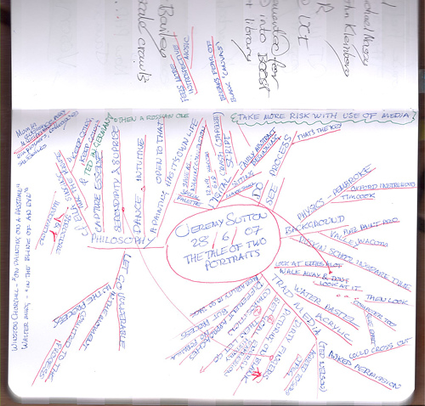More than a year ago I started telling trusted friends and colleagues about a great piece of software. Half-joking, I would lean forward and confide that this is one secret too valuable for me to blog about. The digital equivalent of a performance-enhancing drug, it was something I’d prefer not to leak to competitors. That is, until today. In the spirit of openness, and timed to coincide with my friend Kevin Hillstrom’s One Positive Day campaign for blogging civility, I am ready to spill the beans.
Thinking With Both Sides of the Brain
Ever since my college days I had wondered if there was a smarter way to organize my thoughts. Common note-taking techniques didn’t seem to cut it. Looking around, I wasn’t optimistic. Certainly the first personal computers, with their DOS-like lists, hierarchies and sequences, were of no help.
Then I found the books of British “pop psychology” author Tony Buzan. In a Madison, Wisconsin used bookstore, I discovered the first: a copy of his 1974 Use Both Sides of Your Brain, where he talked about something called mind mapping.
Buzan wrote that standard outlines require scanning from left-to-right, top-to-bottom. This causes the brain to work harder to make the interconnections between concepts.
Back then Buzan couldn’t have envisioned the modern solution to this dilemma, which is to boil lists down to a point where they lose much of their potential meaning and utility. Or conversely, the author will stretch out the information across a blinding sheaf of slides and spray of “bullets.”
I’m referring to Powerpoint of course, a product that Edward Tufte, author of The Visual Display of Quantitative Information and other classics, so eloquently lambastes in this essay.
Our brains are built to survey information as it is seen in the physical world, making associations through placement, space, distance and color. The more complex the subject, the greater our brain resists tidy categorizations and rankings.
Thinking In Mapped Networks
Enter the mind map. The illustration below shows a hand-drawn example. It’s one Buzan that would have been proud to call his own.
To the person who drew it, there is more meaning here than could be crammed into a dozen pages of lists.You can instinctively see how these maps help with lateral associations while still allowing for more formal hierarchies and sequences. As you might expect, some maps are never really completed by their owners. They are continually refined. New insights and perspectives leap off the page with every rereading. This is a good thing, because it shows how concepts can grow and deepen over time.
That was Buzan’s point, and luckily, many modern software developers have listened.
An advantage of the computer-based mind mapping tools is they are easier to share with others (you can even port some softwares’ output to other programs, including … Powerpoint!). Annotation features also help. They add explanation that is needed when you’re showing your map to others — or just trying to remember what the heck you meant when you drew it!
The best mapping tools can even be used as collaborative brainstorming aids. I’ve checked out several over the years, and the best by far is the award-winning Mind Manager. Visit MindJet.com to see for yourself.
Put bluntly, it could change the way you think.

Comments
8 responses to “Thinking in mapped networks, with connections real and implied”
There’s a raft of software for various types of information mapping like mind mapping and concept mapping. And there’s a giant, filterable list of this type of software at Mind-mapping.org
Apart from the free ones (FreeMind, Compendium, Conzilla, View Your Mind, Labrynth and more) there are many on-line-browser-based mind mapping applications now – these have mostly popped up in recent months.
Vic
Thanks, Vic. This is a terrific list!
[…] Source: Digital Solid […]
My latest personal favourite is without question The Personal Brain. http://www.thebrain.com/
Excellent!
Thanks, Lindy —
I’d played with TheBrain.com several years ago, and especially liked the concept of using it for a more fluid way to navigate content. It’s a lot like ThinkMap’s Visual Thesaurus.
Your comment gave me a chance to revisit TheBrain. It looks like they’ve been adding a lot of functionality.
I appreciate the tip.
Hi Jeff,
Did you ever read “Writing the Natural Way”? It was one of the first books to introduce mind-mapping, and it has a novel twist that I haven’t seen elsewhere. The technique is for creative writing. Start by mind-mapping freely. When you *feel* the first sentence, or some other sort of gelling happening, then you start writing. Your left brain starts making a story out of the previously chaotic map and weaves the map together in a most synchronistic way.
I’ve never come across the book, Tim. It makes sense that some creative writers would use mind mapping, since a common and more “sequential” technique is the use of index cards. I’d opt for a mind map any day. 🙂
Good point, Jeff. Yeah, the book is full of exercises. It’s really a hands on thing. I have to say that the writing I did in those exercises certainly had a different quality to them.